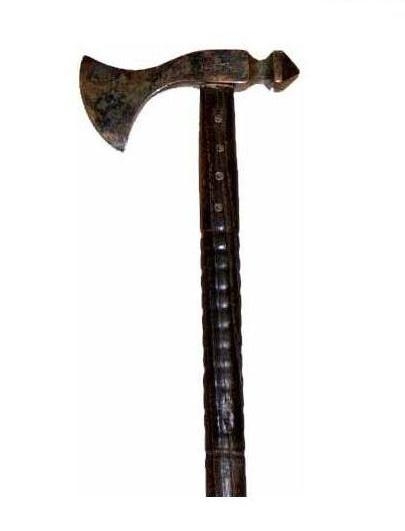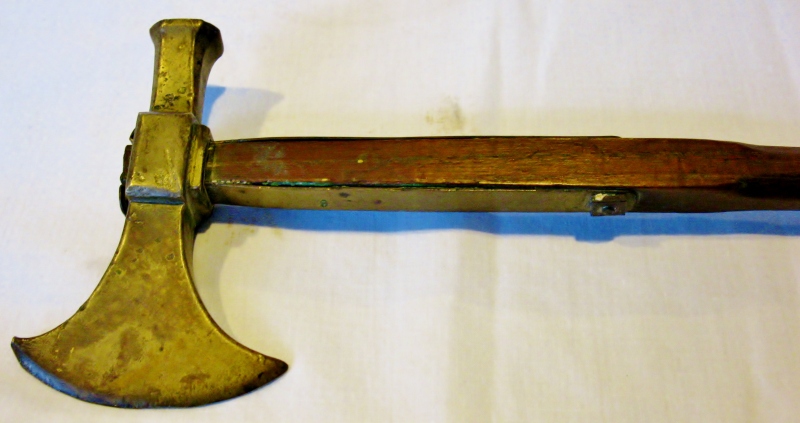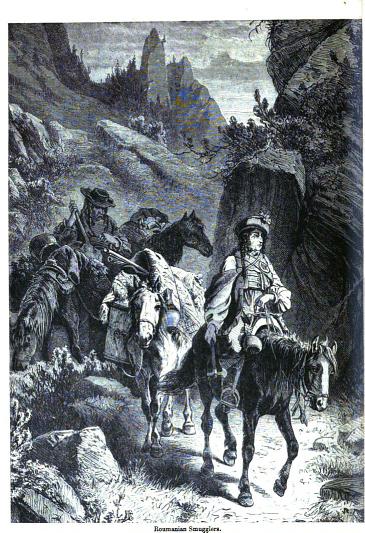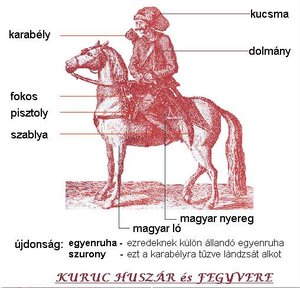| Author |
Message |
Gene W

Location: The South Of England Joined: 01 Dec 2010
Posts: 116
|
 Posted: Sun 15 May, 2011 1:16 pm Post subject: Antique Axe ID required. Posted: Sun 15 May, 2011 1:16 pm Post subject: Antique Axe ID required. |
 |
|
HI All!
These have proven to be a bit of a puzzle.
So far three theories have been put forward.
Indian
Eastern European
Arabian
They are so distinctive, I can't believe that someone won't have a picture at least of an identified example.
Comments welcome,
Thanks as always.
Gene




|
|
  |
 |
|
Ralph Grinly
|
 Posted: Sun 15 May, 2011 2:43 pm Post subject: Posted: Sun 15 May, 2011 2:43 pm Post subject: |
 |
|
|
Indo-Persian Tabars ?? Thats a what they look like to my un-tutored eyes. Whether or not they're old/genuine or " tourist" items is another matter. Judging from the simple punched decoration. I'd be thinking "tourist".
|
|
  |
 |
Gene W

Location: The South Of England Joined: 01 Dec 2010
Posts: 116
|
 Posted: Mon 16 May, 2011 11:28 am Post subject: Posted: Mon 16 May, 2011 11:28 am Post subject: |
 |
|
| Ralph Grinly wrote: | | Indo-Persian Tabars ?? Thats a what they look like to my un-tutored eyes. Whether or not they're old/genuine or " tourist" items is another matter. Judging from the simple punched decoration. I'd be thinking "tourist". |
Hi Ralph,
They are possibly Indian. I don't get an 'Indo Persian' vibe off of them. Definately not tourist items.
Best
Gene
|
|
  |
 |
|
Timo Nieminen
|
 Posted: Tue 17 May, 2011 2:30 am Post subject: Posted: Tue 17 May, 2011 2:30 am Post subject: |
 |
|
Looking at these, my first thought was that the decoration looks Indian, but the axes don't. I hadn't seen anything quite like these, with a round hammer head backing the axe. Without the hammer head, the rest of the head looks very Persian or Turkish. Or possibly Indian.
No axes like this in Egerton or Tirri. Stone has one with a round hammer head, axe #6 in figure 101, "Ceylon or Malabar", mounted quite differently.
With the decoration, they look very "touristy". How do you know that they aren't tourist-market axes?
"In addition to being efficient, all pole arms were quite nice to look at." - Cherney Berg, A hideous history of weapons, Collier 1963.
|
|
   |
 |
Gene W

Location: The South Of England Joined: 01 Dec 2010
Posts: 116
|
 Posted: Tue 17 May, 2011 4:00 am Post subject: Posted: Tue 17 May, 2011 4:00 am Post subject: |
 |
|
| Timo Nieminen wrote: | Looking at these, my first thought was that the decoration looks Indian, but the axes don't. I hadn't seen anything quite like these, with a round hammer head backing the axe. Without the hammer head, the rest of the head looks very Persian or Turkish. Or possibly Indian.
No axes like this in Egerton or Tirri. Stone has one with a round hammer head, axe #6 in figure 101, "Ceylon or Malabar", mounted quite differently.
With the decoration, they look very "touristy". How do you know that they aren't tourist-market axes? |
Hi Timo,
Thanks for the help.
I don't get an even remotely touristy feel from them. The quality (despite the simple decoration) is very good. The seemingly crude dot decoration seems on these sturdy little weapons with their well shaped Crescent blades and finely 'mounted' hammers, more like a tradition than a crude embellishment to atract the eye of the traveller.
Were they thin and flimsy, or generally 'lesser'.... then it would might feel differently to me, but they are right little 'crackers'.
The crescent shape as you note is reminscent of Persian, but not IMHO with that hammer or punched decoration.
Indian remains a good front runner and it has also been suggested that they might be eastern European.
So for me, the decoration and blades look Indian, but the Hammer adds a little confusion.
Look closely, they are clearly the same type but with distinct differences. I would venture that they ARE a distinct ethnographic type and are simply two examples of it, not a pair or just two atypical examples.
Thats why it's so frustrating that I can't seem to 'nail them down' by finding others!
Especially if they were a tourist souvenir, you'd expect to be able to find others fairly easily!
Lots of similar axes, from various places, but none 'tick all the boxes'.
I've searched all my available reference material and seached dozens of web pages and literally thousands of online images.
A suggestion of Hugary/Romania led me to look at various Eastern European 'shepherds/walking axes: 'Fokos', 'valaška', 'ciupaga'.
Interestingly, despite a seeming lack of similarity in the blade shape, I found this quote about a traditional form of decoration:
"Many are considered works of art (esp. those made up to the 60s by highlanders). They were skillfully stamped/adorned according to ancient tradition. The main motives were the sun, stars (whirl), comets, tree of life, flowers, trees such as fir or spruce, and various geometric designs. Some smiths used many different, elaborated stamps."
Best
Gene
|
|
  |
 |
Glen A Cleeton

|
 Posted: Tue 17 May, 2011 7:20 am Post subject: Posted: Tue 17 May, 2011 7:20 am Post subject: |
 |
|
Weapon axes are generally a lot lighter in build than these. They may have been some sort of older parade or ceremonial variety but not fielded weapons. My initial impression is tourist as well. The construct/casting, the very round pole like hafts and the decoration themselves all look tourist or decorative to me. Holding out that they are weapons as opposed to decorative kind of overlooks what weapon axes look like in cross section. These are massive to consider as swung as weapons (not their intention)
The staff/walking axes you are regarding as ethnic (folkos et al) are now decorative and ceremonial only as having brass or alloy heads and being shaped not like these and certainly not on hafts that are knee high. Nor are they pounds of iron, rather slim brass as decorative or very light and thin as the true traditional and functional folkos ( etc by any name)
There are some fireman's ceremonial axes in Europe as well but look nothing like these aside from bulk and those often spiked and gilt painted hafts without the near east flavor of these decorations. A neat pair for the wall but not meant as war tools.
Cheers
GC
|
|
  |
 |
Gene W

Location: The South Of England Joined: 01 Dec 2010
Posts: 116
|
 Posted: Tue 17 May, 2011 7:43 am Post subject: Posted: Tue 17 May, 2011 7:43 am Post subject: |
 |
|
| Glen A Cleeton wrote: | Weapon axes are generally a lot lighter in build than these. They may have been some sort of older parade or ceremonial variety but not fielded weapons. My initial impression is tourist as well. The construct/casting, the very round pole like hafts and the decoration themselves all look tourist or decorative to me. Holding out that they are weapons as opposed to decorative kind of overlooks what weapon axes look like in cross section. These are massive to consider as swung as weapons (not their intention)
The staff/walking axes you are regarding as ethnic (folkos et al) are now decorative and ceremonial only as having brass or alloy heads and being shaped not like these and certainly not on hafts that are knee high. Nor are they pounds of iron, rather slim brass as decorative or very light and thin as the true traditional and functional folkos ( etc by any name)
There are some fireman's ceremonial axes in Europe as well but look nothing like these aside from bulk and those often spiked and gilt painted hafts without the near east flavor of these decorations. A neat pair for the wall but not meant as war tools.
Cheers
GC |
I think the builders angle measure might have led you up the garden path there Glen. Something appears to have?
Do you realise that the larger axe head is 13.5cm overall from tip of cutting edge to top of hammer /10cm across the cutting edge at widest point, Weighing (approx) 380G (minus the short stick, relatively modern replacement shaft.)
The smaller axe head is 10.5cm/9.25cm weighing about the same: 380g.
So whether or not these are weapons or multi purpose, they would certainly be perfect as battle axes and in fact are similar dimensions to axes used in battle throughout the ages.
On a 24" shaft I could swing these comfortably all day. No head would be safe.
While I am not saying that these are in fact Eastern European shepherds axes, it IS one possibility that they are a relation of them.
But again, it seems a truism to have to state that if that IS the case, then they are not the modern decorative brass or wooden reproductions.
They clearly have good age.
Check the Wiki page on shepherds axes for more informationL:
http://en.wikipedia.org/wiki/Shepherd%27s_axe
Attached are two pictures of shepherds axes. One a more traditional shape, the other closer to mine (but again, I repeat that I don't think that mine are these, unless they are one of the specifically weaponised forms mentioned in the Wiki article.

Gene
 Attachment: 33.94 KB Attachment: 33.94 KB

 Attachment: 141.44 KB Attachment: 141.44 KB

Last edited by Gene W on Tue 17 May, 2011 8:04 am; edited 2 times in total
|
|
  |
 |
Glen A Cleeton

|
 Posted: Tue 17 May, 2011 8:02 am Post subject: Posted: Tue 17 May, 2011 8:02 am Post subject: |
 |
|
Yes, I can see the ruler Gene. The path you are paving is your's.
Cheers
GC.
|
|
  |
 |
Gene W

Location: The South Of England Joined: 01 Dec 2010
Posts: 116
|
 Posted: Tue 17 May, 2011 8:14 am Post subject: Posted: Tue 17 May, 2011 8:14 am Post subject: |
 |
|
Just a reference shot in case anyone else is confused..
Not massive, nor pounds in weight.
Small and 380g:

|
|
  |
 |
Romulus Stoica

Location: Hunedoara, Transylvania, Romania Joined: 26 Oct 2006
Posts: 124
|
 Posted: Tue 17 May, 2011 9:23 am Post subject: Posted: Tue 17 May, 2011 9:23 am Post subject: |
 |
|
|
There was a mention about the posibility that those axes could be from Eastern Europe. It is posible, the tulip pattern (often done by points technique) is very common on Hungarian or Székely decorative axes, but usualy those axes have a sharp "beak" instead of a round hammer head back.
|
|
   |
 |
Gene W

Location: The South Of England Joined: 01 Dec 2010
Posts: 116
|
 Posted: Tue 17 May, 2011 1:16 pm Post subject: Posted: Tue 17 May, 2011 1:16 pm Post subject: |
 |
|
| Romulus Stoica wrote: | | There was a mention about the posibility that those axes could be from Eastern Europe. It is posible, the tulip pattern (often done by points technique) is very common on Hungarian or Székely decorative axes, but usualy those axes have a sharp "beak" instead of a round hammer head back. |
Hi Romulus,
Thanks for coming into this discussion.
It's great to have your help.
Can you confirm if it's possible that they could be Romanian?
This picture of 'Romanian Smugglers' was posted by a friend in a discussion elsewhere and we have been trying to find out if the axe in it is accurately drawn or not.
Best
Gene
 Attachment: 60.08 KB Attachment: 60.08 KB

|
|
  |
 |
|
Timo Nieminen
|
 Posted: Tue 17 May, 2011 1:50 pm Post subject: Posted: Tue 17 May, 2011 1:50 pm Post subject: |
 |
|
| Gene W wrote: | | Timo Nieminen wrote: | Looking at these, my first thought was that the decoration looks Indian, but the axes don't. I hadn't seen anything quite like these, with a round hammer head backing the axe. Without the hammer head, the rest of the head looks very Persian or Turkish. Or possibly Indian.
No axes like this in Egerton or Tirri. Stone has one with a round hammer head, axe #6 in figure 101, "Ceylon or Malabar", mounted quite differently.
With the decoration, they look very "touristy". How do you know that they aren't tourist-market axes? |
Hi Timo,
Thanks for the help.
I don't get an even remotely touristy feel from them. The quality (despite the simple decoration) is very good. The seemingly crude dot decoration seems on these sturdy little weapons with their well shaped Crescent blades and finely 'mounted' hammers, more like a tradition than a crude embellishment to atract the eye of the traveller.
Were they thin and flimsy, or generally 'lesser'.... then it would might feel differently to me, but they are right little 'crackers'.
The crescent shape as you note is reminscent of Persian, but not IMHO with that hammer or punched decoration.
Indian remains a good front runner and it has also been suggested that they might be eastern European.
So for me, the decoration and blades look Indian, but the Hammer adds a little confusion.
|
From the hafts, they've been remounted rather crudely, presumably for sale rather than use, which smells very touristy to me. Might the decoration date from that remounting? Could be older military axes done up for tourist sale.
("Tourist" doesn't mean crap, at least not always. A good reproduction of a genuine weapon can be perfectly functional, depending on metallurgy.)
I don't think it's East European, or a "walking axe". The point sticking up makes it less functional as such. Given that the closest match for the head (the combination of blade shape, round hammer head, and I think size too) is the example in Stone, I'd guess Indian. If the remounting is recent and for sale, then only the head is diagnostically useful.
(Another though was Sudanese, imitating Persian style. But I think these heads are too well-done for that. And I've not seen any Sudanese axes with round hammer heads.)
"In addition to being efficient, all pole arms were quite nice to look at." - Cherney Berg, A hideous history of weapons, Collier 1963.
|
|
   |
 |
Sean Flynt

|
|
   |
 |
Simon G.

|
 Posted: Tue 17 May, 2011 2:47 pm Post subject: Posted: Tue 17 May, 2011 2:47 pm Post subject: |
 |
|
| Quote: |
("Tourist" doesn't mean crap, at least not always. A good reproduction of a genuine weapon can be perfectly functional, depending on metallurgy.) |
Very true, I own a Tuareg knife made for the tourist trade, and its craftsmanship is not crude at all. There is a lot of tourist crap, to be sure, but there are also some items made to be sold to tourists that are worth having.
|
|
   |
 |
Romulus Stoica

Location: Hunedoara, Transylvania, Romania Joined: 26 Oct 2006
Posts: 124
|
 Posted: Tue 17 May, 2011 10:32 pm Post subject: Posted: Tue 17 May, 2011 10:32 pm Post subject: |
 |
|
| Quote: | | This picture of 'Romanian Smugglers' was posted by a friend in a discussion elsewhere and we have been trying to find out if the axe in it is accurately drawn or not |
This picture looks like being from late XVIII century to me so I think "Romanian Smugglers" is not an adequate term  . Romania, as a state, didn't exists at that time. They look like south-western transylvanian smugglers and they could be either transylvanian romanians, székelys, transylvanian magyars, or serbs/croatians. The smuggler bands were (and still are) never strictly "national" groups . Romania, as a state, didn't exists at that time. They look like south-western transylvanian smugglers and they could be either transylvanian romanians, székelys, transylvanian magyars, or serbs/croatians. The smuggler bands were (and still are) never strictly "national" groups  ... ...
The small axe in the picture could be a transylvanian baltag or a hungarian / székely fokos.
|
|
   |
 |
|
Ralph Grinly
|
 Posted: Wed 18 May, 2011 12:13 am Post subject: Posted: Wed 18 May, 2011 12:13 am Post subject: |
 |
|
|
There's an article on Indian/Persian Tabars in the Dec 2010/Jan 2011 issue of the english "Classical Arms and Militaria" magazine. The artlicle shows several different varieties and blade shapes- some thin bladed, some quite thick, like the photos shown. I've also got one myself - I'll try to get a photo of it and posat it shortly.
|
|
  |
 |
Gene W

Location: The South Of England Joined: 01 Dec 2010
Posts: 116
|
 Posted: Wed 18 May, 2011 2:05 am Post subject: Posted: Wed 18 May, 2011 2:05 am Post subject: |
 |
|
| Romulus Stoica wrote: | | Quote: | | This picture of 'Romanian Smugglers' was posted by a friend in a discussion elsewhere and we have been trying to find out if the axe in it is accurately drawn or not |
This picture looks like being from late XVIII century to me so I think "Romanian Smugglers" is not an adequate term  . Romania, as a state, didn't exists at that time. They look like south-western transylvanian smugglers and they could be either transylvanian romanians, székelys, transylvanian magyars, or serbs/croatians. The smuggler bands were (and still are) never strictly "national" groups . Romania, as a state, didn't exists at that time. They look like south-western transylvanian smugglers and they could be either transylvanian romanians, székelys, transylvanian magyars, or serbs/croatians. The smuggler bands were (and still are) never strictly "national" groups  ... ...
The small axe in the picture could be a transylvanian baltag or a hungarian / székely fokos. |
Hi Romulus,
Thanks for your help 
I've looked for a transcript of the article in the magazine. Obviously I'm just reproducing it verbatim:
"CHATTER BOX
Published for the Proprietors by W. WELLS GARDNER, 10 Paternoster Row, London. Printed by John Strangeways,] [Castle Street, Leicester Square
No. 18. March 30, 1872. Weekly—One Halfpenny.
ROUMANIAN SMUGGLERS.
ROUMANIA, otherwise called Wallachia and Moldavia, a country watered by the Danube, and not far from the Black Sea, is inhabited by a wild and lawless set of people, who have proved themselves very difficult to rule, and who are constantly changing their government.
Smuggling in this land is by no means confined to the lower classes. Even the nobles are engaged in it. They smuggle goods chiefly to and from Austria, through the wild passes of the Carpathian Mountains. The horses they employ in this trade are small, wiry, and strong; as to the appearance of the men themselves, it is certainly picturesque, their costume being a mixture of that of several nations. The hat is Hungarian, generally gaily decorated; on their shoulder is an embroidered leather strap, which indicates that its owner has once served as a soldier in the Austrian armv; the linen shirt has a Wallachian cut. and the girdle round the waist, which is richly embroidered, betrays the same nationality. The foot-gear of the men in our illustration is not Wallachian, for they always wear sandals, and our cavalier with the hatchet in his hand wears high bpots. It is a strange article which these men are going to smuggle over into Austria, and which they carry in stone pitchers—it is leeches, which are abundant in Roumania, and upon which there is a heavy export duty. It is through one of the narrow, steep passes of the Carpathian .Mountains that these smugglers are passing, wishing of course to avoid the Custom-houses. They carry other things as well as leeches, probably a good stock of tobacco; and if they succeed m keeping their booty safe they will make a large profit. Seven villages in a lonely valley among the Carpathian Mountains are famous as the abode of smugglers, and to these places the government often send an armed band of Custom-house officers, who search every house, and generally carry off rich spoil, in spite of the clever way in which the smugglers hide their contraband goods."
Interestingly the site I found this transcript on also mentions a Description of the “mountaineers” in the Carpathians from 1844.
“The mountaineers here are called Huzzulen as in Bukovina. We found two of them sitting by the fire at the inn, leaning upon their hatchets. They told us that they were never without their hatchets, that they travelled with them, danced with them, and wore them as a part of their Sunday finery. They went to church with their hatchets, but did not take them into the church. They hung them upon wooden posts outside, from which each on coming out took down his own again.”
I've looked at lots of axes from these regions but not managaed to find any that are a match to my examples.
If you have any further thoughs on them I'd appreciate it.
Best
Gene
|
|
  |
 |
Gene W

Location: The South Of England Joined: 01 Dec 2010
Posts: 116
|
 Posted: Wed 18 May, 2011 2:06 am Post subject: Posted: Wed 18 May, 2011 2:06 am Post subject: |
 |
|
| Ralph Grinly wrote: | | There's an article on Indian/Persian Tabars in the Dec 2010/Jan 2011 issue of the english "Classical Arms and Militaria" magazine. The artlicle shows several different varieties and blade shapes- some thin bladed, some quite thick, like the photos shown. I've also got one myself - I'll try to get a photo of it and posat it shortly. |
Hi Ralph,
That would be great, thanks.
Best
Gene
|
|
  |
 |
Gene W

Location: The South Of England Joined: 01 Dec 2010
Posts: 116
|
 Posted: Wed 18 May, 2011 2:38 am Post subject: Posted: Wed 18 May, 2011 2:38 am Post subject: |
 |
|
| Sean Flynt wrote: | | Shepherd's Axe! Never heard of such a thing but it illuminates the small axes sometimes shown in use by higher-status soldiers in Austrian/German painting of the late 15th and early 16th centuries. There must be a connection between those weapons and tools. |
Hi Sean,
There is a whole family of these axes in eastern Europe.
Often, these 'shepherds axes' bear a striking similarity to arabian Shihuh axes.
Long handle, slightly downcurving 'tomahawk' style blade.
Also, the problem is that there are lots of sub-groups (in both general types).
The general form of the shepherds axe allows for using it as a walking stick, and in fact modern tourist versions are often wooden or soft metal representations that wouldn't be usable as axes.
However, the two axes of mine would be impossible to hold in this way.
Also, I've not seen a single one with a circular shaft hole. they are always squared off or long oval.
There are though, seemingly weaponised versions where the 'hiking' aspect wasn't needed.
In some illustrations and paintings I've found, these look 'somewhat' like mine, ranging through to more or less like a classic war-hammer.
"In Hungary, modified axes were also used as martial weapons by Hungarian warriors in the medieval age, used for example in the 18th century in Rákóczi's War for Independence against Austrian soldiers. In the 17th and 18th century, Hungarian Kuruc leader Imre Thököly and his soldiers used shepherd's axes as weapons. Hungarian shepherds in the northern regions used it also as a tool."
So, as it stands, the shape of the blade may fit with 'some' eastern European axes, and also Indian axes, possibly even Arabian axes.
The Punched decoration is a bit of a minefield as it seems to also have several possible origins.
It certainly has an Indian look, but the designs are very reminiscent of Eastern Europe as well and I have a reference that seems to indicate a possible connection with axes, "They were skillfully stamped/adorned according to ancient tradition. The main motives were the sun, stars (whirl), comets, tree of life, flowers, trees such as fir or spruce, and various geometric designs. Some smiths used many different, elaborated stamps."
It's a puzzle! And thats' before we explore the Arabian possibility. Axes can be a minefield! LOL
Best
Gene
 Attachment: 22.08 KB Attachment: 22.08 KB

Illustration to show possible Hungarian weaponised form.
|
|
  |
 |
Gene W

Location: The South Of England Joined: 01 Dec 2010
Posts: 116
|
 Posted: Wed 18 May, 2011 2:59 am Post subject: Posted: Wed 18 May, 2011 2:59 am Post subject: |
 |
|
| Timo Nieminen wrote: | From the hafts, they've been remounted rather crudely, presumably for sale rather than use, which smells very touristy to me. Might the decoration date from that remounting? Could be older military axes done up for tourist sale.
("Tourist" doesn't mean crap, at least not always. A good reproduction of a genuine weapon can be perfectly functional, depending on metallurgy.)
I don't think it's East European, or a "walking axe". The point sticking up makes it less functional as such. Given that the closest match for the head (the combination of blade shape, round hammer head, and I think size too) is the example in Stone, I'd guess Indian. If the remounting is recent and for sale, then only the head is diagnostically useful.
(Another though was Sudanese, imitating Persian style. But I think these heads are too well-done for that. And I've not seen any Sudanese axes with round hammer heads.) |
Hi Timo,
The shafts are similar but very crude. The larger was fitted reasonably well, with small wooden wedges. But still doesn't look original. The smaller axes has a similar shaft but just roughly knocked on. Both are easily removable. Completely inappropriate for axes with circular shaft holes.
These are items that have probobly been in the UK for generations. I would theorise that the original shafts may have been damaged through misuse or age or rot etc, and a previous owner replaced them so the axes could be displayed.
The UK is quite literally awash with the spoils of centuries of Empire. Ethnographic weapons have only recently been valued (sadly) and I've seen the most horrible 'home mods' done by uninformed owners in times past.
Not to mention modifications for theatrical re-use!
I agree that these are wrong for shepherds/walking axes. But it's possible that they could be a 'relative'.
I personally lean towards Indian, but without a verifed example to compare, I fear they will remain a mystery. 
Best
Gene
|
|
  |
 |
|
|
You cannot post new topics in this forum
You cannot reply to topics in this forum
You cannot edit your posts in this forum
You cannot delete your posts in this forum
You cannot vote in polls in this forum
You cannot attach files in this forum
You can download files in this forum
|
All contents © Copyright 2003-2024 myArmoury.com — All rights reserved
Discussion forums powered by phpBB © The phpBB Group
Switch to the Basic Low-bandwidth Version of the forum
|

